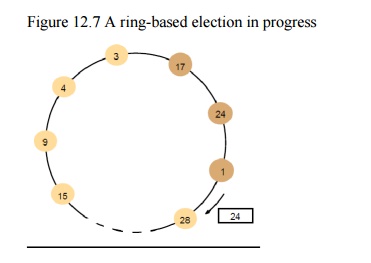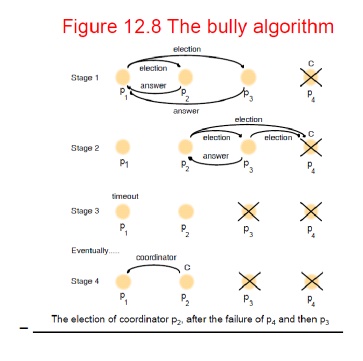Chapter: Distributed Systems : Synchronization and Replication
Elections in Distributed Systems
Elections
– Election:
choosing a unique process for a particular role
– All the
processes agree on the unique choice
– For
example, server in dist. Mutex assumptions
– Each process
can call only one election at a time multiple concurrent elections can be
called by different processes
– Participant:
engages in an election each process pi
has variable electedi = ? (don't
know) initially process with the largest
identifier wins.
– The
(unique) identifier could be any useful value Properties
– [E1] electedi of a ―participant‖ process must be P (elected
process=largestid) or ⊥
– (undefined)
o
[E2] liveness: all processes participate and
eventually set electedi != ⊥ (or crash) Performance
– overhead
(bandwidth consumption): # of messages
– turnaround
time: # of messages to complete an election
– ring-based
election algorithm
o
Arrange processes in a logical ring
– pi sends messages to p(i+1) mod N
o It could
be unrelated to the physical configuration
o Elect the
coordinator with the largest id
o Assume no
failures
– Initially,
every process is a non-participant. Any process can call an election
o Marks
itself as participant
o Places
its id in an election message
o Sends the
message to its neighbor
o Receiving
an election message
– if id > myid, forward the msg, mark participant
– if id < myid
o non-participant:
replace id with myid: forward the msg, mark participant
o participant:
stop forwarding (why? Later, multiple elections)
– if id = myid,
coordinator found, mark non-participant, electedi
:= id, send elected
o message
with myid
o Receiving
an elected message
– id != myid, mark non-participant,
electedi := id forward the msg
– if id = myid,
stop forwarding

– Receiving
an election message:
– if id > myid, forward the msg, mark participant
– if id < myid
– non-participant:
replace id with myid: forward the msg, mark participant
– participant:
stop forwarding (why? Later, multiple elections)
– if id = myid,
coordinator found, mark non-participant, electedi
:= id, send elected message with
– myid
– Receiving
an elected message: – id != myid, mark non-participant,
– electedi := id forward the msg
– if id = myid,
stop forwarding
– ring-based
election algorithm: discussion
o
•Properties
o
safety: only the process with the largest id can
send an elected message
o
liveness: every process in the ring eventually
participates in the election; extra elections are stopped
o
Performance
o
one election, best case, when?
o
N
election messages
o
N elected
messages
o
turnaround: 2N
messages
o
one election, worst case, when?
o
2N - 1
election messages
o
N elected
messages
o
turnaround: 3N
- 1 messages
o
can't tolerate failures, not very practical
– The bully
election algorithm
– •Assumption
o
Each process knows which processes have higher
identifiers, and that it can communicate with all such processes
– •Compare
with ring-based election
o
Processes can crash and be detected by timeouts
– synchronous
– timeout T = 2Ttransmitting
(max transmission delay) + Tprocessing
(max processing delay)
– •Three
types of messages
o
Election: announce an election
o
Answer: in response to Election
o
Coordinator: announce the identity of the elected
process
– The bully
election algorithm: howto
§ Start an
election when detect the coordinator has failed or begin to replace the coordinator,
which has lower identifier
o
Send an election message to all processes with
higher id's and waits for answers (except the failed coordinator/process)
§ If no
answers in time T
o
Considers it is the coordinator
o
sends coordinator message (with its id) to all
processes with lower id's
§ else
o
waits for a coordinator message and starts an
election if T‘ timeout
o
To be a coordinator, it has to start an election
§ A higher
id process can replace the current coordinator (hence ―bully‖)
o
The highest one directly sends a coordinator
message to all process with lower identifiers
§ Receiving
an election message
o
sends an answer message back
o
starts an election if it hasn't started one—send
election messages to all higher-id processes (including the ―failed‖
coordinator—the coordinator might be up by now)
§ Receiving
a coordinator message
o
set electedi
to the new coordinator

– The bully
election algorithm: discussion
– Properties
– safety:
– a
lower-id process always yields to a higher-id process
– However,
it‘s guaranteed
–
if processes that have crashed are replaced by
processes with the same identifier since message delivery order might not be
guaranteed and
–
failure detection might be unreliable
–
liveness: all processes participate and know the
coordinator at the end
–
Performance
–
best case: when?
–
overhead: N-2
coordinator messages
–
turnaround delay: no election/answer messages
Related Topics